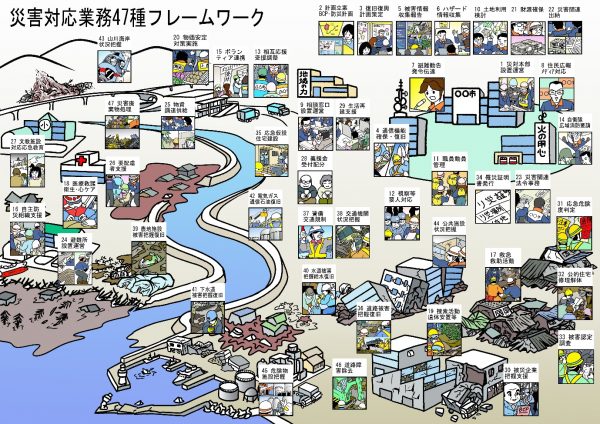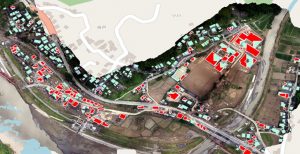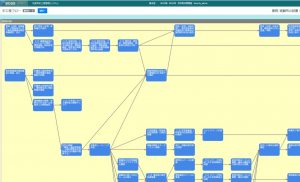
February 10, 2021
コロナ禍での災害対応の研究Research on disaster management under COVID-19
新型コロナウイルスは私たちの日常を大きく変えてしまいましたが、それは災害時も同様です。沼田研究室では、コロナ禍での自然災害について研究を進めています。災害対応の全体の業務の中で、コロナに関しては、特に、災害現場でリモートによる迅速な被害状況の把握、住民が密集し感染症が拡大するリスクが高い避難所運営が今まで以上に重要になりました。
1点目の迅速な被害状況の把握については、迅速に広域的な被害状況を把握するために、無人航空機(UAV)など空撮画像を用いた自然災害後の建物被害の検出と被害情報の共有手法の構築を行っています。ブルーシートがかかった家屋の抽出においては,RGB値*の差分や閾値による演算と対象地域の建物ポリゴンデータ*を用いることによって,被災した家屋の一括的な抽出ができました。その一方で,建物被害が多くみられるが災害現場のブルーシートがかかっていない空撮画像を用いた解析では,被害建物のRGB値が一定ではないため,被害の教師データ*やCNN*のモデルを作成し,機械学習を用いて解析しました。解析の範囲やCNNのモデルの検証,検証データを建物ポリゴンの形状にトリミングし,リサイズする等により,機械判読の効率を最適化させ,短時間で学習・検証を行うことができました。
2点目の避難所運営については、避難所開設後に発生する感染症に関する研究は多いものの、感染症拡大下での避難所運営についての研究は少ないです。また、内閣府等のガイドラインに基づき、各自治体はコロナ禍での避難所運営マニュアルを作成し感染症対策を進めていますが、さらに検討する必要があると考えています。まず、コロナによる避難生活に対する考え方の変化を明らかにするため、全国の市民に調査しました。その結果、コロナ前後で避難所生活を希望する人が減り、この傾向が高齢者と同居する方で大きいことが分かりました。次に、神奈川県川崎市との共同により、避難所運営業務を対象とし、災害対応工程管理システムBOSSを用いたコロナ禍での実証実験を行いました。BOSS(Business Operation Support System)とは、業務の効率化を目指し、各業務をフローチャートの形で流れが分かるようにデータベース化したものです。実証実験は、感染症対策業務の増加により以前に増して業務の効率化の必要性が高まっていることを踏まえ、従来の紙面によるマニュアルとの比較により、BOSS使用の効果を明らかにし、感染症対策業務に関する示唆を得ることを目的としました。その結果、BOSSの使用によりリーダーが明確な指示を出すことが可能になり、業務分担や滞留時間の短縮に繋がること、ゾーニングの関連業務に問題が生じやすいことが明らかになりました。
そして現在は、上記で得られた結果を実際のコロナ禍での避難所運営と比較するために実施した、全国の自治体へ調査の分析を進めています。今後、自治体で実現可能な対策の検討を深めていきたいと考えています。
これらの研究成果は、日本地震工学会での発表1)2)、IntechOpen3)、Public Health分野4)、JDR5)への論文投稿や、NHKなどに取り上げられたことにより、社会に発信しました。
*RGB値:パソコンなどのモニター上での色の表現方法のひとつ。赤(R)緑(G)青(Bの光の3原色を組み合わせて色を表現する。
*建物ポリゴンデータ:建物を上から見た輪郭を線で囲んだデータのこと。
*教師データ:機械学習で人工知能にあらかじめ与える例題と解答のデータ。
*CNN:Convolutional Neural Networkの略。機械学習で情報量の圧縮を繰り返しおこなうこと。
〈LINKS〉
1) 谷口幸弥・沼田宗純:空撮画像を用いた建物被害の抽出と共有手法の構築、日本地震工学会・大会、A-2-8、一般講演、12月2日発表、2020.
2) 安井あり紗・沼田宗純「災害対応工程管理システムBOSSとマニュアルによる新型コロナウイルス流行下での避難所運営を事例とした対応行動の比較」、日本地震工学会・大会、C-3-2、一般講演、12月2日発表、2020. [優秀発表賞 受賞]
3) A. Yasui, M. Numada, and C. Krishna, “Disaster Management Process Approach: Case Study by BOSS for Disaster Response under COVID-19,” [Online First], IntechOpen, 2020.
https://www.intechopen.com/online-first/disaster-management-process-approach-case-study-by-boss-for-disaster-response-under-covid-19
4) A. Yasui and M. Numada, “A Report of the Questionnaire Survey on Awareness of COVID-19 and Shelters,” Journal of Disaster Research, Vol.16, No.3, 2020. [accepted]
5) Arisa Yasui, Muneyoshi Numada, Makoto Bando, Shintaro Nakano and Chaitanya Krishna: A Study on the Current Situation of Prearranged Shelter Management in Japan for Making a Standard Operation Procedure, International Journal of Environmental Research and Public Health, 2020, 17(24).
https://www.mdpi.com/1660-4601/17/24/9545/htm
記事:谷口幸弥(先端表現コース 修士課程)、安井あり紗(工学系研究科社会基盤学専攻 修士課程)、沼田宗純(准教授)
英文校正:デービッド・ビュースト(特任専門員)
COVID-19 has changed our daily lives significantly, even in the event of a disaster. At Numada Laboratory, we are conducting research on natural disasters under COVID-19. In the totality of disaster management research with regards to COVID-19, it is more important than ever to grasp the damage situation remotely at the disaster site and to manage evacuation centers, where there is a high risk of infectious diseases spreading due to the concentration of residents.
Regarding the first research, quick grasp of the damage situation, in order to quickly grasp the damage situation over a wide area, we developed a method for detecting building damage after a natural disaster and sharing damage information using aerial images such as those taken by UAVs. In the identification of houses covered with blue sheets, it was possible to collectively extract the damaged houses by calculating the difference of RGB values, threshold values and the building polygon data of the target area. On the other hand, in analysis using aerial images of disaster sites where there are many damaged buildings but they are not covered by blue sheets, the RGB values of the damaged buildings are not constant, so teacher-data about damages and CNN models have been created and analysis carried out using machine learning. By adjusting the range of analysis and the CNN layer, trimming the validation data to the shape of the building polygon, and resizing it, the efficiency of machine reading is optimized, and learning and validation have been performed in a short time.
For the second research, we have first surveyed citizens nationwide to clarify the changes in their thinking about shelter life. As a result, it was found that the number of people who wished to live in a shelter decreased before and after COVID-19, and this tendency was greater for those living with the elderly. Next, in Kawasaki City, Kanagawa Prefecture, we conducted a demonstration experiment using BOSS for shelter operation. BOSS (Business Operation Support System) is a database of each business in the form of a flowchart with the aim of improving business efficiency. The purpose of the demonstration experiment was to clarify the effect of using BOSS and obtain suggestions on infectious disease countermeasures, based on the fact that the need for more efficient work is increasing due to the increase in infectious disease control work. As a result, it became clear that the use of BOSS allows leaders to give clear instructions, leading to division of duties and reduction of residence time, and that problems related to zoning are likely to occur.
We are currently proceeding with analysis of a survey conducted by local governments nationwide to compare the results obtained above with actual shelter operation under COVID-19. In the future, we would like to deepen the examination of measures that can be implemented by local governments.
These results were disseminated to society through the submission of papers and presentations at the Japan Association for Earthquake Engineering.
〈LINKS〉
1) 谷口幸弥・沼田宗純:空撮画像を用いた建物被害の抽出と共有手法の構築、日本地震工学会・大会、A-2-8、一般講演、12月2日発表、2020.
2) 安井あり紗・沼田宗純「災害対応工程管理システムBOSSとマニュアルによる新型コロナウイルス流行下での避難所運営を事例とした対応行動の比較」、日本地震工学会・大会、C-3-2、一般講演、12月2日発表、2020. [優秀発表賞 受賞]
3) A. Yasui, M. Numada, and C. Krishna, “Disaster Management Process Approach: Case Study by BOSS for Disaster Response under COVID-19,” [Online First], IntechOpen, 2020.
https://www.intechopen.com/online-first/disaster-management-process-approach-case-study-by-boss-for-disaster-response-under-covid-19
4) A. Yasui and M. Numada, “A Report of the Questionnaire Survey on Awareness of COVID-19 and Shelters,” Journal of Disaster Research, Vol.16, No.3, 2020. [accepted]
5) Arisa Yasui, Muneyoshi Numada, Makoto Bando, Shintaro Nakano and Chaitanya Krishna: A Study on the Current Situation of Prearranged Shelter Management in Japan for Making a Standard Operation Procedure, International Journal of Environmental Research and Public Health, 2020, 17(24).
https://www.mdpi.com/1660-4601/17/24/9545/htm
Text: Yukiya Taniguchi (Masters Student, GSII), Arisa Yasui (Masters Student, School of Engineering), Muneyoshi Numada (Associate Professor)
Proofreading: David Buist (Project Senior Specialist)
主担当教員Associated Faculty Members
准教授
沼田 宗純
- 先端表現情報学コース
Associate Professor
NUMADA, Muneyoshi
- Emerging design and informatics course





